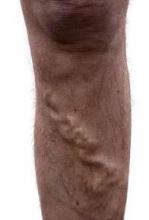Ultrasound-guided foam sclerotherapy, endovenous laser ablation, and surgery for the treatment of varicose veins were generally similar with respect to quality of life measures and clinical efficacy and safety in a randomized trial involving 785 patients.
At 6 months, disease-specific quality of life was slightly worse after treatment with foam than after surgery (effect size, –1.74; P = .006). A post hoc analysis showed slightly better generic quality of life after laser ablation than after foam sclerotherapy (effect size, 1.54; P = .048).
In addition, a lower rate of procedural complications occurred with laser ablation (1%, compared with 6% and 7% for foam sclerotherapy and surgery, respectively), and a lower rate of completely successful ablation of great saphenous veins at 6 weeks occurred after foam treatment (55%, compared with 84% and 83% for the surgery and laser groups, respectively).
Dr. Julie Brittenden of the University of Aberdeen, Scotland, and her colleagues reported the findings online Sept. 25 in the New England Journal of Medicine (N. Engl. J. Med. 2014 Sept. 25 [doi: 10/1056/NEJMoa1400781]).
Subjects in the Comparison of Laser, Surgery, and Foam Sclerotherapy (CLASS) trial were adults with primary varicose veins who were treated at 11 centers in the United Kingdom between November 2008 and October 2012. They were evaluated at 6 weeks and 6 months after treatment.
The baseline scores and overall improvements in quality of life seen in the CLASS trial were comparable to those in smaller European randomized trials, which supports the generalizability of the findings, the investigators said.
This study was supported by a grant from the Health Technology Assessment Programme of the U.K. National Institute for Health Research. Dr. Brittenden reported having no other disclosures.


